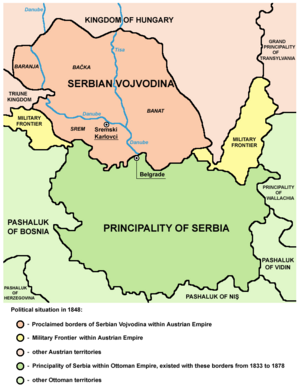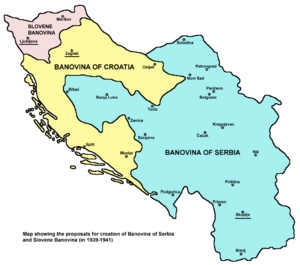History of modern Serbia facts for kids
The history of modern Serbia is about how Serbia became the country it is today. It starts in the early 1800s when Serbia began to break free from the Ottoman Empire. Later, it was part of Yugoslavia, and now it is the independent Republic of Serbia.
Contents
Serbia's Beginnings (1804–1876)
The story of modern Serbia started with a big fight for freedom from the Ottoman Empire in 1804. This was called the Serbian Revolution. Serbs fought hard to gain some independence. The First Serbian Uprising in 1804 and the Second Serbian Uprising in 1815 were key moments. Even though Turkish soldiers stayed in Belgrade until 1867, these revolutions made Serbs proud and hopeful.
In 1829, Greece became fully independent. Serbia also gained a special kind of independence, meaning it was semi-independent from Turkey. Serbia's first constitution, called the Sretenje or Candlemas constitution, was created in 1835. It was later replaced by the Constitution of 1838.

During the Revolutions of 1848, Serbs living in the Austrian Empire declared their own area called Serbian Vojvodina. In 1849, the Austrian emperor turned this area into a special region called the Voivodeship of Serbia and Temes Banat. This region was later removed in 1860, but Serbs there got another chance to achieve their goals in 1918. Today, this area is known as Vojvodina.
Full Independence in 1878
Serbia and Montenegro went to war with Turkey in 1876, but they lost badly. Then, Russia, which felt a connection to Slavic people (a feeling called Pan-Slavism), decided to help. Russia joined the war against Turkey in 1877, and this time, they won! This victory brought full independence for Serbia. Serbia also gained new lands to the south-east, including Niš, which became Serbia's second-largest city. Some of the gains from an early agreement, the Treaty of San Stefano, were changed by other powerful countries at the Treaty of Berlin (1878).
The Serbian Kingdom was officially declared in 1882, with King Milan I as its ruler. Serbia was one of the few countries at that time that had its own ruling family on the throne. However, millions of Serbs still lived outside Serbia in other empires. Russia and Austria often got involved in Serbia's politics.
The new country was mostly a farming land, with little industry. It was quite poor, like many other countries in the Balkans. The population grew from one million in the early 1800s to 2.5 million by 1900. Belgrade had about 100,000 people then.
Serbia's internal politics often involved a rivalry between two royal families: the Obrenović family and the Karađorđević family. These families were descendants of important leaders from the Serbian Revolution. The Obrenovići ruled from 1817–1842 and 1858–1903. The Karađorđevići ruled from 1842–1858 and after 1903. King Milan I, an Obrenović, ruled from 1868 to 1889. He made Serbia's foreign policy friendly with Austria-Hungary to gain their support.
Early 1900s and Growing Tensions
The Karađorđević family preferred Russia. They came to power in June 1903 after a military coup. After this, Serbia became closer to Russia. Serbia then often challenged Austria-Hungary.
In October 1908, Austria-Hungary took over Bosnia-Herzegovina. Serbia wanted this territory for itself, so it strongly opposed this. This led to the Bosnian crisis. Powerful countries like Germany and Austria-Hungary pressured Russia to make Serbia accept the takeover. Russia agreed but promised to protect Serbia's independence in the future.
After Bulgaria became independent from the Ottoman Empire in 1908, and Greece also became more nationalistic, Serbia joined with these countries and Montenegro. In October 1912, they invaded Ottoman-held Macedonia. This reduced the Ottoman Empire's land in Europe to a small area around Constantinople (now Istanbul).
Bulgaria later tried to take more land from its allies in July 1913, but it failed. This led to the Balkan Wars. Serbia's territory almost doubled, which worried Austria-Hungary. Bulgaria also felt cheated because it didn't get the land it thought it deserved.
Serbia in World War I
On June 28, 1914, Archduke Franz Ferdinand of Austria, who was next in line to the throne of Austria-Hungary, was visiting Sarajevo. A young Bosnian Serb nationalist named Gavrilo Princip shot and killed the Archduke and his wife. Princip and his friends had come from Belgrade. Serbian Major Vojislav Tankosić had provided them with weapons and helped them prepare.
Austria-Hungary and Germany asked Serbia to investigate the plot in Serbia. Serbia refused. On July 23, Austria-Hungary sent an ultimatum (a final demand) to Serbia. It asked Serbia to respect Austria-Hungary's territory and have good relations. Serbia had 48 hours to respond. If Serbia didn't agree, Austria-Hungary would remove its diplomats.
Serbia sent a polite reply, agreeing to most points. However, it did not agree to allow Austrian officials to take part in a criminal investigation in Serbia. Before sending its reply, the Serbian army was mobilized. In response, Austria-Hungary removed its ambassador. On July 28, 1914, Austria-Hungary officially declared war on Serbia.
Serbia fought back against three invasions by Austria-Hungary in 1914. Belgrade was even briefly held by the enemy. But in 1915, a terrible disease called typhus weakened the Serbian army. In October, Germany and Bulgaria joined the invasion, and the whole country was occupied. The remaining Serbian forces retreated into Albania and Macedonia.
During the war, many Serbs suffered greatly. Serbia had the highest number of casualties compared to other European countries, losing over 30% (1.3 million) of its total population.
In September 1918, the Allied forces launched a successful attack. This led to Bulgaria's surrender and then the liberation of Serbia in November 1918. On November 25, the people of Vojvodina voted to join Serbia. On November 29, Montenegro also voted to unite with Serbia. Two days later, leaders from the South Slav regions of Austria-Hungary voted to join the new State of Slovenes, Croats and Serbs.
Serbia Since 1918
After World War I, the Kingdom of Serbia was restored. It then joined with other South Slavic lands that were once part of Austria-Hungary. This new country was called the Kingdom of Serbs, Croats and Slovenes. It was later renamed Yugoslavia in 1929. This new kingdom was formed on December 1, 1918, and lasted until 1941.
From 1918 to 1941, Serbia didn't exist as a separate political area. The Kingdom of Yugoslavia was a central country. It was divided into administrative regions that didn't follow ethnic or historical borders. However, a Serb king ruled the country, and Serb politicians had a lot of power. This caused some unhappiness among Croats, who wanted the country to be more federal. In 1939, a compromise was reached, and a new province called the Banovina of Croatia was created. Some Serb thinkers also wanted the remaining Yugoslav provinces to form a new Banovina of Serbia, but this never happened.
In 1941, during World War II, the Axis Powers invaded and occupied Yugoslavia. German forces created an occupied territory called Serbia. They set up a Serbian government that followed their orders. This occupied Serbia included most of today's Republic of Serbia. Some areas were taken by other countries like Croatia, Hungary, Bulgaria, and Italy. The Banat region, part of occupied Serbia, had a special status and was governed by its German minority.
Besides the Serbian government that worked with the Axis, two groups fought against the Axis in Serbia. These were the royalist Chetniks and the communist Partisans. These two resistance groups also fought against each other, leading to a civil war in Serbia. For a short time in 1941, the communist Partisans created a small area called the Republic of Užice in southwestern Serbia. But this was soon destroyed by Axis troops and Serbian forces working with them.
In 1944, the Soviet Red Army and Yugoslav Partisans drove all Axis troops out of Serbia. The area became part of a restored Yugoslavia. Unlike the Yugoslavia before the war, which had a central government, the post-war Yugoslavia was set up as a federation of six equal republics. One of these republics was Serbia. It had two autonomous (self-governing) provinces: Vojvodina and Kosovo. From the 1974 Yugoslav constitution, these provinces gained many political rights. They were even represented separately from Serbia in some parts of the federal government, though they were still officially part of Serbia.
The new Serbian constitution from 1990 greatly reduced the independence of Kosovo and Vojvodina. It made the central government in Serbia much stronger. After the Socialist Federal Republic of Yugoslavia broke apart in 1991–1992, Serbia and Montenegro formed a new country called the Federal Republic of Yugoslavia.
After conflicts between the Kosovo Liberation Army and Serbian and Yugoslav authorities, and the NATO bombing of Yugoslavia in 1999, Kosovo became a special area protected by the United Nations. In 2003, the Federal Republic of Yugoslavia changed its name to the State Union of Serbia and Montenegro. Then, after Montenegro voted for independence in 2006, Serbia and Montenegro became two separate countries. In 2008, Kosovo declared its independence from Serbia. Many countries in Europe and around the world have recognized Kosovo's independence since then.
See also




